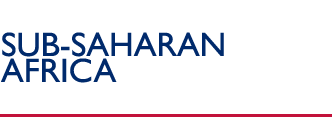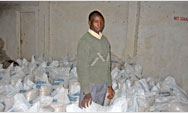Initiative to End Hunger in Africa (IEHA)
The cycle of hunger in sub-Saharan Africa begins and ends with poverty-the inability to grow or purchase food causes malnutrition and poor health, which in turn leads to the inability to earn income and to deeper poverty. It is estimated that one in three Africans are undernourished. To break this cycle, African leaders have recognized that increased economic growth, driven by agriculture, is essential.
Launched in 2002, the Presidential Initiative to End Hunger in Africa (IEHA) is a multi-year effort designed to help increase agricultural income and fulfill the United Nations' Millennium Development Goal of cutting the number of hungry people in Africa in half by 2015. This initiative focuses on promoting agricultural growth and building an African-led partnership to cut hunger and poverty by investing in agriculture oriented towards toward small-scale farmers. At a time when the challenge of food security in the region has never been greater, IEHA investments are having a significant impact and providing a solid foundation to respond to the food challenge.
Global Partnerships
IEHA builds economic governance and global partnerships that can effectively create the conditions for agriculture to flourish by working with African governments, regional organizations, multilateral development institutions, the private sector, universities, and other nongovernmental organizations. USAID is working to develop programs and policies that open up markets to agricultural trade, improve infrastructure, support small-scale farmers, provide safety nets to the most vulnerable groups, and exploit technological advances. USAID is also working with the African Union's New Partnership for Africa's Development (AU/NEP) and donor partners to address the policy and technical barriers that are making countries famine prone. All of these efforts are aligned with and directly support the AU/NEPAD Comprehensive African Agriculture Development Program.
The Comprehensive Africa Agricultural Development Program (CAADP) is the most ambitious and comprehensive agricultural reform effort ever undertaken in Africa. CAADP addresses policy and capacity issues to achieve an annual 6-percent agricultural growth rate. It is led by Africans to ensure that agriculture plays its critical role in supporting transformational development. CAADP promotes African mutual accountability and donor coordination. It integrates vulnerable populations into the mainstream development agenda and provides a framework for Africans to assist famine-prone countries tackle the root causes of hunger.
Science and Technology
Science and technology are key to providing innovations that increase agricultural productivity while reducing vulnerabilities and risks. The essence of the IEHA science and technology strategy is to encourage partnerships among U.S. universities, international researchers, and African researchers that invest in agricultural research, institutions, networking, and training. This will accelerate the development of science-based solutions for African farmers' problems.
Linking Producers to Markets
USAID assists governments and regional organizations and helps build the capacity of private sector organizations to create a supportive environment for the marketing and trade of agricultural products through programs that, among other things, develop agricultural markets for crops, seeds, and fertilizers, and build physical infrastructure, such as rural roads, necessary for market access.
Reaching Out to the Vulnerable
Through IEHA, USAID's Africa Bureau and the Bureau for Democracy, Conflict, and Humanitarian Assistance are working with international donor partners, governments, the private sector, and local NGOs to break the cycle of famine by supporting sustainable agriculture programs that protect and build assets, develop integrated nutrition strategies and implement community-based nutrition programs, help countries to analyze the impact of HIV/AIDS on agriculture, and reduce the vulnerability of the poor to drought or floods, market crashes, or conflict.
IEHA currently supports efforts in Ghana, Kenya, Mali, Mozambique, Uganda, and Zambia and regional programs in east, west, and southern Africa. In FY 2008 one "hunger hot spot" country, Malawi, was included in IEHA.
Through sustained investments in agriculture- based programs that are carried out in conjunction with programs to improve health, education, infrastructure, environment, and public policy management, USAID is introducing political and technical options for reversing the trends of hunger and poverty in Africa. Some successes in 2007 include:
- Over 17 million rural people-including 1.7 million vulnerable households-directly benefited
- More than 12,000 producer and trade associations received technical assistance to strengthen their organizations
- More than a million men and 641,000 women received training
- More than 1,500 women's organizations received technical assistance
- Over 3,800 agriculture-related firms benefited from IEHA assistance
- Five hundred eighty-one new public-private partnerships were formed
- Over 900,000 farmers adopted new technologies on 300,000 hectares
- Forty-five processors adopted new technologies;
- Intra-regional trade increased 9 percent-from $227 million in 2006 to $247 million in 2007
- Regional trade in maize increased 135 percent-from $32 million in 2006 to $76 million in 2007
- Intra-regional trade in dairy products increased from $6.9 million in 2006 to $7.2 million in 2007
Back to Top ^
|


